Abstract
To quantify the potential of brown adipose tissue as a target organ for glucose oxidation, O2 consumption and glucose metabolism in isolated rat brown adipocytes were measured in the presence and absence of insulin, by using the beta-agonists isoprenaline or Ro 16-8714 to stimulate thermogenesis. Basal metabolic rate (278 mumol of O2/h per g of lipid) was maximally stimulated with isoprenaline (20 nm) and Ro 16-8714 (20 microM) to 1633 and 1024 mumol of O2/h per g respectively, whereas insulin had no effect on O2 consumption. Total glucose uptake, derived from the sum of [U-14C]glucose incorporation into CO2 and total lipids and lactate release, was enhanced with insulin. Isoprenaline and Ro 16-8714 had no effect on insulin-induced glucose uptake, but promoted glucose oxidation while inhibiting insulin-dependent lipogenesis and lactate production. A maximal value for glucose oxidation was obtained under the combined action of Ro 16-8714 and insulin, which corresponded to an equivalent of 165 mumol of O2/h per g of lipid. This makes it clear that glucose is a minor substrate for isolated brown adipocytes, fuelling thermogenesis by a maximum of 16%.
Full text
PDF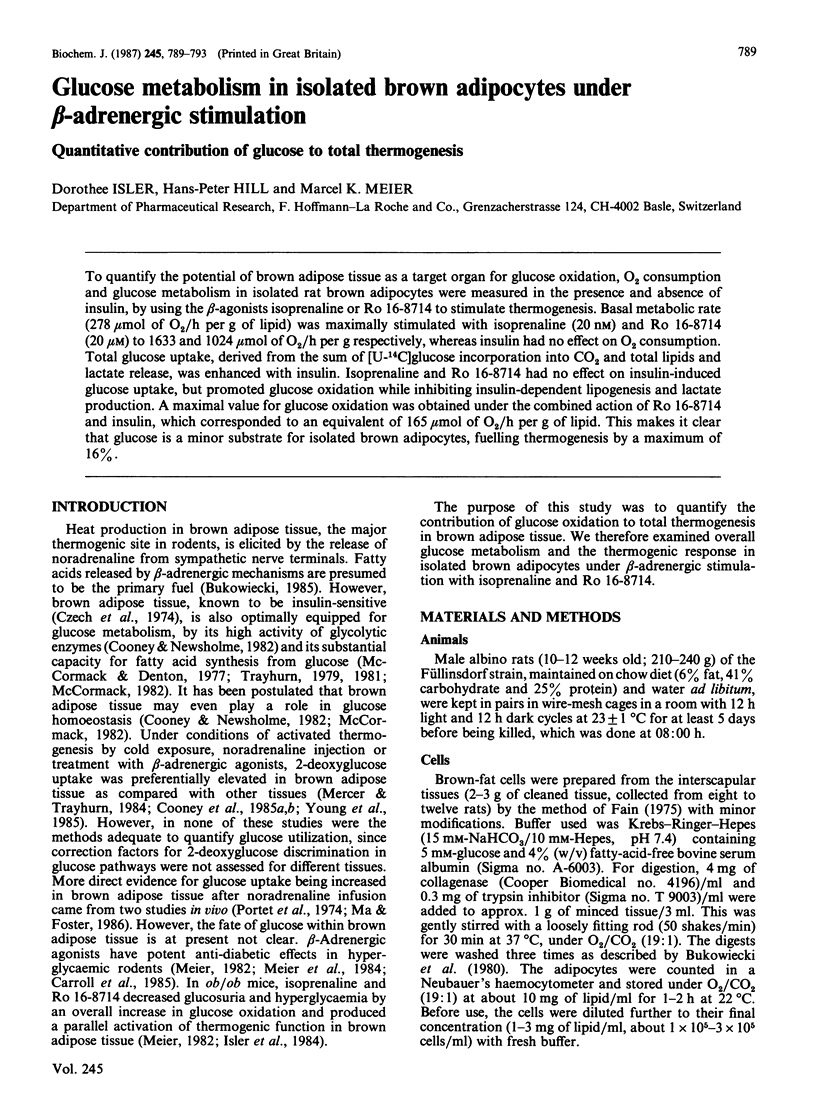
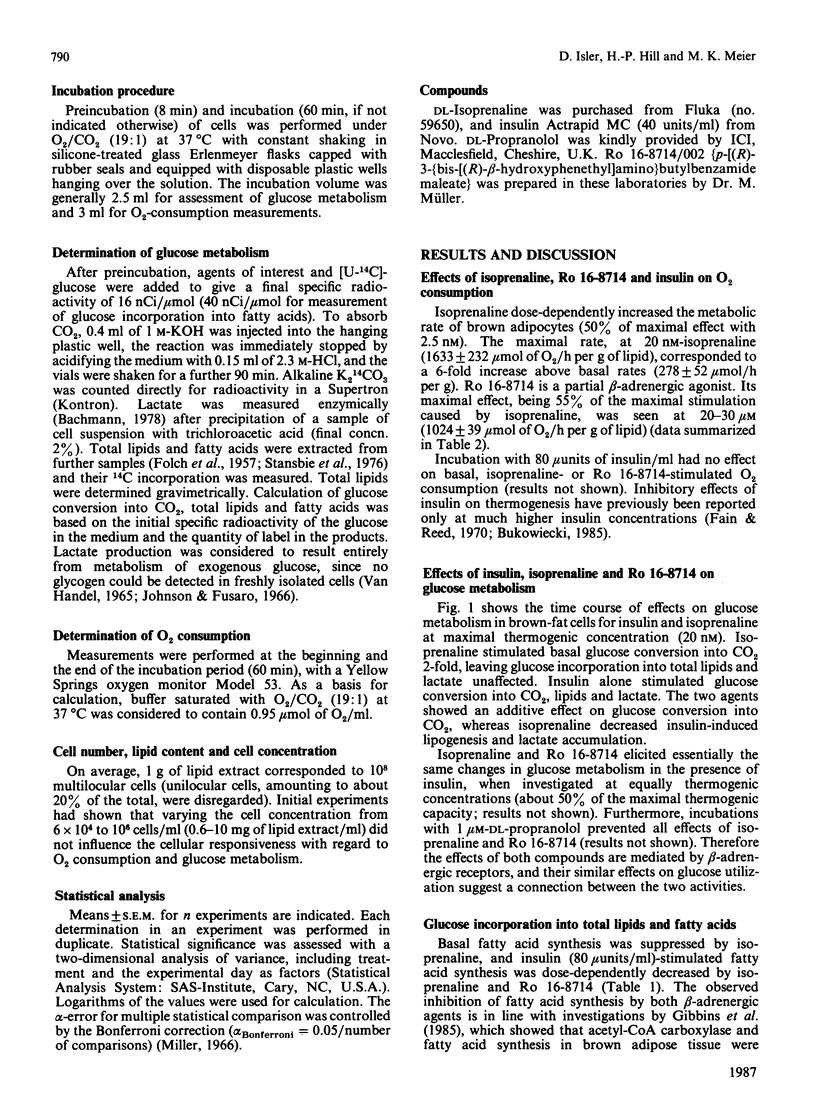
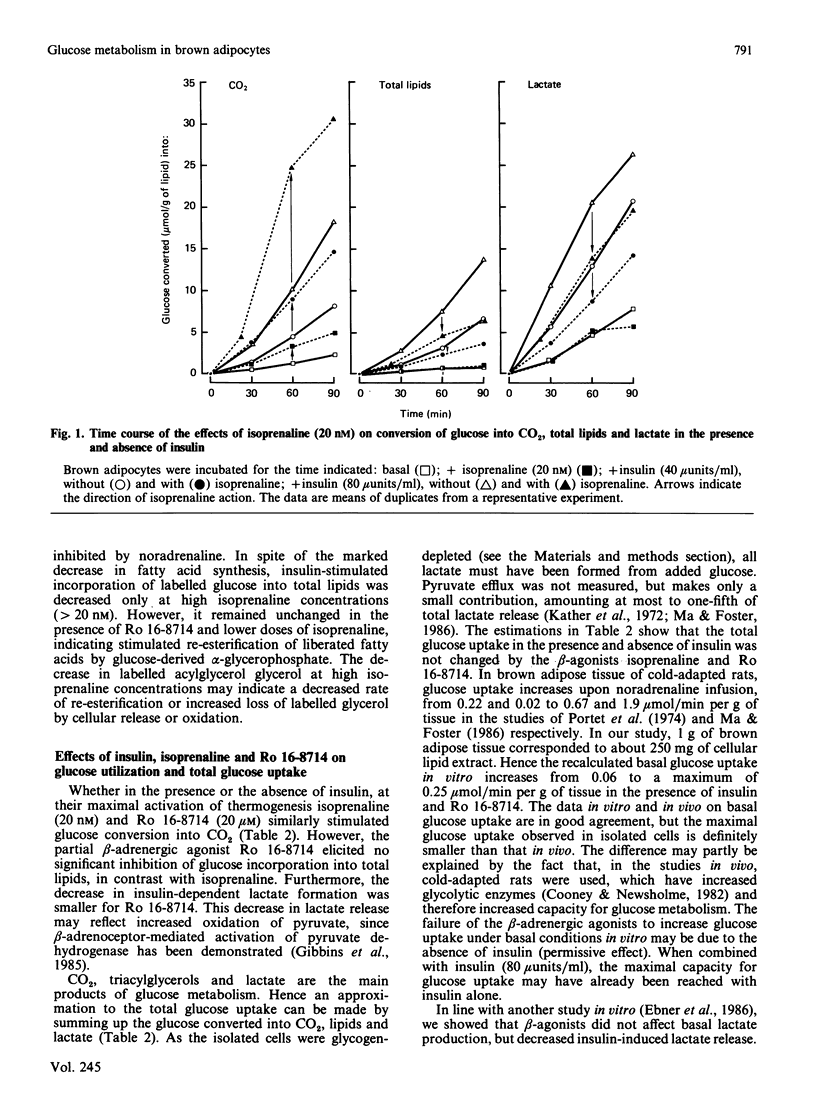
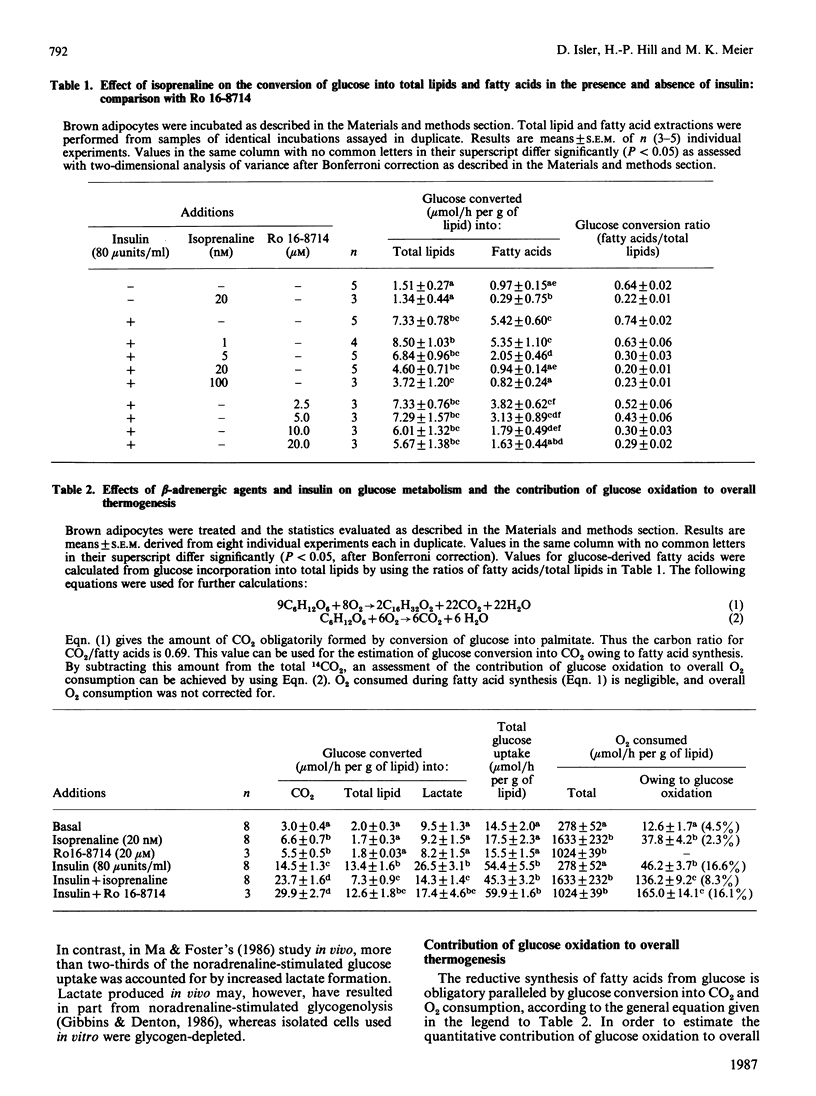
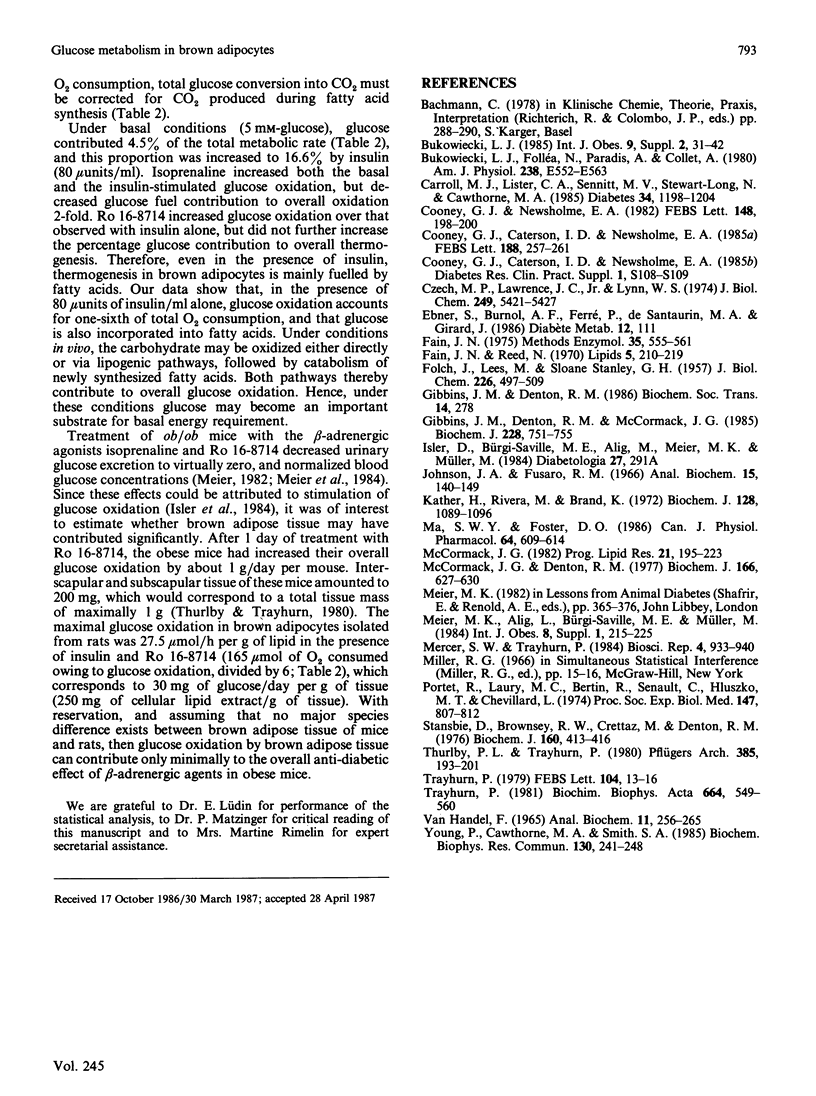
Selected References
These references are in PubMed. This may not be the complete list of references from this article.
- Bukowiecki L., Folléa N., Paradis A., Collet A. Stereospecific stimulation of brown adipocyte respiration by catecholamines via beta 1-adrenoreceptors. Am J Physiol. 1980 Jun;238(6):E552–E563. doi: 10.1152/ajpendo.1980.238.6.E552. [DOI] [PubMed] [Google Scholar]
- Carroll M. J., Lister C. A., Sennitt M. V., Stewart-Long N., Cawthorne M. A. Improved glycemic control in C57Bl/KsJ (db/db) mice after treatment with the thermogenic beta-adrenoceptor agonist, BRL 26830. Diabetes. 1985 Nov;34(11):1198–1204. doi: 10.2337/diab.34.11.1198. [DOI] [PubMed] [Google Scholar]
- Cooney G. J., Caterson I. D., Newsholme E. A. The effect of insulin and noradrenaline on the uptake of 2-[1-14C]deoxyglucose in vivo by brown adipose tissue and other glucose-utilising tissues of the mouse. FEBS Lett. 1985 Sep 2;188(2):257–261. doi: 10.1016/0014-5793(85)80383-5. [DOI] [PubMed] [Google Scholar]
- Cooney G. J., Newsholme E. A. The maximum capacity of glycolysis in brown adipose tissue and its relationship to control of the blood glucose concentration. FEBS Lett. 1982 Nov 8;148(2):198–200. doi: 10.1016/0014-5793(82)80807-7. [DOI] [PubMed] [Google Scholar]
- Czech M. P., Lawrence J. C., Jr, Lynn W. S. Hexose transport in isolated brown fat cells. A model system for investigating insulin action on membrane transport. J Biol Chem. 1974 Sep 10;249(17):5421–5427. [PubMed] [Google Scholar]
- FOLCH J., LEES M., SLOANE STANLEY G. H. A simple method for the isolation and purification of total lipides from animal tissues. J Biol Chem. 1957 May;226(1):497–509. [PubMed] [Google Scholar]
- Fain J. N. Isolation of free brown and white fat cells. Methods Enzymol. 1975;35:555–561. doi: 10.1016/0076-6879(75)35184-7. [DOI] [PubMed] [Google Scholar]
- Fain J. N., Reed N. A mechanism for hormonal activation of lipolysis and respiration in free brown fat cells. Lipids. 1970 Feb;5(2):210–219. doi: 10.1007/BF02532471. [DOI] [PubMed] [Google Scholar]
- Gibbins J. M., Denton R. M., McCormack J. G. Evidence that noradrenaline increases pyruvate dehydrogenase activity and decreases acetyl-CoA carboxylase activity in rat interscapular brown adipose tissue in vivo. Biochem J. 1985 Jun 15;228(3):751–755. doi: 10.1042/bj2280751. [DOI] [PMC free article] [PubMed] [Google Scholar]
- Johnson J. A., Fusaro R. M. The quantitative enzymic determination of animal liver glycogen. Anal Biochem. 1966 Apr;15(1):140–149. doi: 10.1016/0003-2697(66)90256-9. [DOI] [PubMed] [Google Scholar]
- Kather H., Rivera M., Brand K. Interrelationship and control of glucose metabolism and lipogenesis in isolated fat-cells. Effect of the amount of glucose uptake on the rates of the pentose phosphate cycle and of fatty acid synthesis. Biochem J. 1972 Aug;128(5):1089–1096. doi: 10.1042/bj1281089. [DOI] [PMC free article] [PubMed] [Google Scholar]
- Ma S. W., Foster D. O. Uptake of glucose and release of fatty acids and glycerol by rat brown adipose tissue in vivo. Can J Physiol Pharmacol. 1986 May;64(5):609–614. doi: 10.1139/y86-101. [DOI] [PubMed] [Google Scholar]
- McCormack J. G., Denton R. M. Evidence that fatty acid synthesis in the interscapular brown adipose tissue of cold-adapted rats is increased in vivo by insulin by mechanisms involving parallel activation of pyruvate dehydrogenase and acetyl-coenzyme A carboxylase. Biochem J. 1977 Sep 15;166(3):627–630. doi: 10.1042/bj1660627. [DOI] [PMC free article] [PubMed] [Google Scholar]
- McCormack J. G. The regulation of fatty acid synthesis in brown adipose tissue by insulin. Prog Lipid Res. 1982;21(3):195–223. doi: 10.1016/0163-7827(82)90009-1. [DOI] [PubMed] [Google Scholar]
- Mercer S. W., Trayhurn P. The development of insulin resistance in brown adipose tissue may impair the acute cold-induced activation of thermogenesis in genetically obese (ob/ob) mice. Biosci Rep. 1984 Nov;4(11):933–940. doi: 10.1007/BF01116891. [DOI] [PubMed] [Google Scholar]
- Portet R., Laury M. C., Bertin R., Senault C., Hluszko M. T., Chevillard L., Le Blanc J. Hormonal stimulation of substrate utilization in brown adipose tissue of cold acclimated rats. Proc Soc Exp Biol Med. 1974 Dec;147(3):807–812. doi: 10.3181/00379727-147-38443. [DOI] [PubMed] [Google Scholar]
- Stansbie D., Brownsey R. W., Crettaz M., Denton R. M. Acute effects in vivo of anti-insulin serum on rates of fatty acid synthesis and activities of acetyl-coenzyme A carboxylase and pyruvate dehydrogenase in liver and epididymal adipose tissue of fed rats. Biochem J. 1976 Nov 15;160(2):413–416. doi: 10.1042/bj1600413. [DOI] [PMC free article] [PubMed] [Google Scholar]
- Thurlby P. L., Trayhurn P. Regional blood flow in genetically obese (ob/ob) mice. The importance of brown adipose tissue to the reduced energy expenditure on non-shivering thermogenesis. Pflugers Arch. 1980 Jun;385(3):193–201. doi: 10.1007/BF00647457. [DOI] [PubMed] [Google Scholar]
- Trayhurn P. Fatty acid synthesis in mouse brown adipose tissue. The influence of environmental temperature on the proportion of whole-body fatty acid synthesis in brown adipose tissue and the liver. Biochim Biophys Acta. 1981 Jun 23;664(3):549–560. doi: 10.1016/0005-2760(81)90132-6. [DOI] [PubMed] [Google Scholar]
- Trayhurn P. Fatty acid synthesis in vivo in brown adipose tissue, liver and white adipose tissue of the cold-acclimated rat. FEBS Lett. 1979 Aug 1;104(1):13–16. doi: 10.1016/0014-5793(79)81075-3. [DOI] [PubMed] [Google Scholar]
- Van Handel E. Estimation of glycogen in small amounts of tissue. Anal Biochem. 1965 May;11(2):256–265. doi: 10.1016/0003-2697(65)90013-8. [DOI] [PubMed] [Google Scholar]
- Young P., Cawthorne M. A., Smith S. A. Brown adipose tissue is a major site of glucose utilisation in C57Bl/6 ob/ob mice treated with a thermogenic beta-adrenoceptor agonist. Biochem Biophys Res Commun. 1985 Jul 16;130(1):241–248. doi: 10.1016/0006-291x(85)90408-5. [DOI] [PubMed] [Google Scholar]


